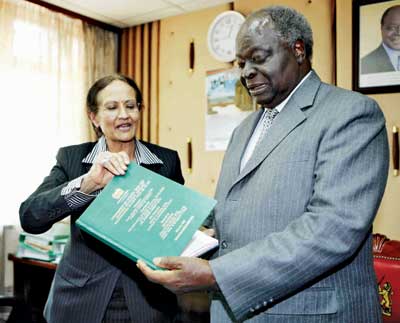By Lilian Aluanga-Delvaux
 |
|
Lady Justice Kalpana Rawal hands over the inquiry report into Saitoti plane crash to former President Kibaki.[Photos: File] |
NAIROBI, KENYA: Witnesses to the helicopter crash that killed former Internal Security minister George Saitoti, his deputy Orwa Ojode, and four others gave accounts that support a finding that bad weather played a role in the incident.
The report of the Commission of Inquiry into the helicopter crash quotes Patrick Ndung’u, a farmhand at the Napenda Kuishi Boys Centre, describing the last minutes of the ill-fated flight.
Ndung’u said he was attending to his duties when he heard and saw the police helicopter flying north from the direction of Ngong Hills. Ndung’u, who is referred to as CW38, said the chopper was flying very low, “barely above the trees of a height of about 20m”.
He said the helicopter was making a frightening sound as it went out of view about two minutes after he saw it, after which he heard a crash.
High sound
The accident, which took place in Ngong’s Kibiku area, killed Saitoti, Ojode, pilots Nancy Gituanja and Luke Oyugi, and police bodyguards Thomas Murimi and Joshua Tonkei.
Ms Anastacia Mulei, an official at the Napenda Kuishi home, also said she saw the helicopter approach from the direction of Limuru, to the north. Mulei, who is referred to as CW36, said it was flying low that she could read the legend ‘Kenya Police’ on its belly, despite the misty, drizzling weather.
“The sound it made was loud. It went lower and then high again,” she said. The helicopter disappeared to the south before turning back.
It was so close to the ground, she said, it caused the buildings to shake. She thought it might strike an electricity pole about 200m from where she was standing.
Shortly after, the witness said she heard a bang then saw fire followed by smoke.
CW37, Salim Montet, who is a neighbour to Mulei, also testified to hearing and seeing the helicopter approach from the north, flying so low that it hit a blue gum tree on his farm. He, too, said the aircraft went south towards the Ngong Hills then returned about two minutes later, going northwards very low and fast.
Mr Montet claimed he saw fire trailing the helicopter from the exhaust and heard an unusual cracking or grinding sound. Less than two minutes later, it dropped into the forest.
Misty weather
Like Mulei and Montet, witness CW61, identified as Richard Harney, also reported the weather was misty, with visibility at about 500m.
Stay informed. Subscribe to our newsletter
Harney, an advocate of the High Court, told the inquiry he was cycling about a kilometre or two from the accident site when he heard a helicopter overhead “flying quite low”. He observed that it was a “damp, grey morning, and the cloud was particularly low”.
In his testimony, the witness said he “distinctly thought it was quite unusual for a helicopter to be flying that low in such weather”.
He looked up but was unable to see the craft due to the misty weather. In his estimation, the helicopter circled twice and was in the area between six and eight minutes before he heard a sound like a muffled gas explosion.
Captain Ian Mimano, CEO at Lady Lori, said although the weather was not a problem at take off from the Wilson Airport, things rapidly changed after takeoff.
Mr Mimano, also referred to as CW35 in the report, is a pilot with over 4,000 flight hours.
He testified how he took off a few minutes after 8am on the material day on a flight to Lewa, north of Nairobi about 14 minutes before the ill-fated flight took to the skies.
After climbing to approximately 500 feet above the ground, Mimano continued to fly at the same height, in order to stay above the clouds.
Reduced visibility
However, in a few minutes the cloud base got lower as the aircraft crossed Waiyaki Way, near Safaricom House, to the north of Wilson Airport.
Visibility was also rapidly reducing, according to his judgement, and he was forced to slow down the helicopter to 60 knots (the recommended speed when encountering hazardous situations) even as he attempted to manoeuvre the aircraft to stay in visual conditions.
In the end, he radioed Wilson Airport Control Tower to inform them he was going to divert to Windsor Hotel due to worsening weather conditions. He landed at about 8.30am, just as the Saitoti chopper was crashing into the ground in Kibiku.
 The Standard Group Plc is a
multi-media organization with investments in media platforms spanning newspaper
print operations, television, radio broadcasting, digital and online services. The
Standard Group is recognized as a leading multi-media house in Kenya with a key
influence in matters of national and international interest.
The Standard Group Plc is a
multi-media organization with investments in media platforms spanning newspaper
print operations, television, radio broadcasting, digital and online services. The
Standard Group is recognized as a leading multi-media house in Kenya with a key
influence in matters of national and international interest.
 The Standard Group Plc is a
multi-media organization with investments in media platforms spanning newspaper
print operations, television, radio broadcasting, digital and online services. The
Standard Group is recognized as a leading multi-media house in Kenya with a key
influence in matters of national and international interest.
The Standard Group Plc is a
multi-media organization with investments in media platforms spanning newspaper
print operations, television, radio broadcasting, digital and online services. The
Standard Group is recognized as a leading multi-media house in Kenya with a key
influence in matters of national and international interest.






